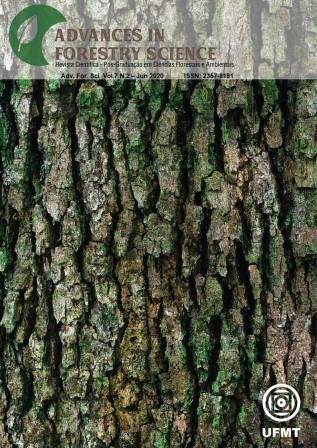Exploratory analysis of nutrient concentrations in Eucalyptus leaf color patterns
DOI:
https://doi.org/10.34062/afs.v7i2.8647Keywords:
Leaf senescence, Remobilization, Munsell color, Visual diagnosisAbstract
The aim of this study was to evaluate the use of leaf color pattern to analyze leaf nutrient concentrations in Eucalyptus and to establish relationships between color patterns and leaf nutrient concentrations. The study was carried out in Eucalyptus stands at 25 months old using three leaves from the lower of tree crowns classified into five color patterns of Munsell color charts for plant tissues. The principal component analyses and the self-organizing maps were used to aid in the classification of samples in leaf color patterns. Subsequently, the k-means cluster algorithm was performed. In principal component analysis, the 7.5 GY 8/8 leaf color pattern stood out from the others and it was mainly influenced by nitrogen, phosphorous, copper, and potassium concentrations. The samples of 7.5 GY 8/4 leaf color pattern did not present a great nitrogen, phosphorous, sulfur, copper and potassium concentrations as the 7.5 GY 8/8 neither a great manganese, calcium, boron, zinc and iron concentrations as others leaf color patterns. The self-organizing map provides a greater proximity between the 7.5 GY 8/8 and 7.5 GY 8/4 leaf color patterns and the others leaf color patterns were randomly distributed in the U-matrix. Although the k-means algorithm presented two clusters in both analyses, the self-organizing map presented a slight superiority than principal component analysis. Using leaf color patterns was possible to infer about leaf nutrient concentrations in Eucalyptus. Both methods were able to distinguish only the healthy leaves 7.5 GY 8/8 from those whose were in the leaf senescence process.
Downloads
References
Avice J-CC, Etienne P (2014) Leaf senescence and nitrogen remobilization efficiency in oilseed rape (Brassica napus L.). Journal of Experimental Botany, 65:3813-3824. doi: 10.1093/jxb/eru177.
Brosse S, Giraudel JL, Lek S (2001) Utilisation of non-supervised neural networks and principal component analysis to study fish assemblages. Ecological Modelling, 146:159-166. doi: 10.1016/S0304-3800(01)00303-9.
Clevers JGPW, Gitelson AA (2001) Remote estimation of crop and grass chlorophyll and nitrogen content using red-edge bands on Sentinel-2 and -3. International Journal of Applied Earth Observation and Geoinformation, 23:344-351. doi: 10.1016/j.jag.2012.10.008.
Chon T-S (2011) Self-Organizing Maps applied to ecological sciences. Ecological Informatics, 6:50-61. doi: 10.1016/j.ecoinf.2010.11.002.
Ebensen KH (2002) Multivariate data analysis: In practice. 5th Edition. Oslo: CAMO Process AS. 587 p.
Gitelson AA, Merzlyak, MN, Lichtenthaler HK (1996) Detection of red edge position and Chlorophyll. Journal Plant of Physiology, 148:501-508. doi: 10.1016/S0176-1617(96)80285-9.
Himelblau E, Amasino RM (2001) Nutrients mobilized from leaves of Arabidopsis thaliana during leaf senescence. Journal of Plant Physiology, 158:1317-1323. doi: 10.1078/0176-1617-00608.
Hörtensteiner S, Kräutler B (2011) Chlorophyll breakdown in higher plants. Biochimica et Biophysoca Acta, 1807:977-988. doi: 10.1016/j.bbabio.2010.12.007.
Ibá – Industria Brasileira De Árvores. Relatório anual da IBÁ 2017, ano base 2016. 2017. 80 p.
Kalteh AM, Hjorth P, Berndtsson R (2008) Review of the self-organizing map (SOM) approach in water resources: Analysis, modelling and application. Environmental Modelling & Software, 23:835-845. doi: 10.1016/j.envsoft.2007.10.001
Karcher DE, Richardson MD (2003) Quantifying turfgrass color using digital image analysis. Crop Science, 43:943-951. doi: 10.2135/cropsci2003.9430.
Kohonen T (1982) Self-organized formation of topologically correct feature maps. Biological Cybernetics, 43:59-69. doi: 10.1007/BF00337288.
Kohonen T (2001) Self-organizing maps. 3rd Edition. Berlin: Springer. 501 p.
Marschner H (2011) Marschner’s mineral nutrition of higher plants. London: Academic Press. 651 p.
Maillard A, Diguélou S, Billard V, Laine P, Garnica M, Prudent M, Garcia-Mina JM, Yvin JC, Ourry A (2015) Leaf mineral nutrient remobilization during leaf senescence and modulation by nutrient deficiency. Frontiers in Plant Science, 6:1-15, 2015. doi: 10.3389/fpls.2015.00317.
Oliveira LFR, Oliveira MLR, Gomes FS, Santana RC (2017) Estimating foliar nitrogen in Eucalyptus using vegetation indexes. Scientia Agricola, 74:142-147. doi: 10.1590/1678-992x-2015-0477.
Pimstein A, Karnieli A, Bansal SK, Bonfil DJ (2011) Exploring remotely sensed technologies for monitoring wheat potassium and phosphorus using field spectroscopy. Field Crops Research, 121:125-135. doi: 10.1016/j.fcr.2010.12.001.
R Core Team (2017). R: A language and environment for statistical computing. R Foundation for Statistical Computing, Vienna, Austria. URL http://www.R-project.org/.
Raese JT, Drake SR, Curry EA (2011) Nitrogen fertilizer influences fruit quality, soil nutrients and cover crops, leaf color and nitrogen content, biennial bearing and cold hardiness of ‘golden delicious’. Journal of Plant Nutrition, 30:1585-1604. doi: 10.1080/01904160701615483.
Santana RC, Fontan ICI, Oliveira SL (2014) Implantação, manutenção e produtividade dos povoamentos. In: Vale AB, Machado CC, Pires JMM, Vilar MB, Costa CB, Nacif AP (ed) Eucaliptocultura no Brasil: Silvicultura, Manejo e Ambiência. Belo Horizonte: Suprema. p. 161-186.
Saur E, Nambiar EKS, Fife DN (2000) Foliar nutrient retranslocation in Eucalyptus globulus. Tree Physiology, 20:1105–1112. doi: 10.1093/treephys/20.16.1105.
Thomas H, Stoddart JL (1980) Leaf senescence. Annual Review of Plant Physiology, 31:83-111. doi: 10.1146/annurev.pp.31.060180.000503.
Downloads
Published
Issue
Section
License
All copyright must be assigned to the Federal University of Mato Grosso.

